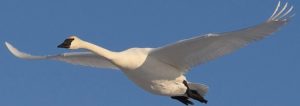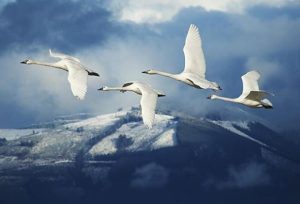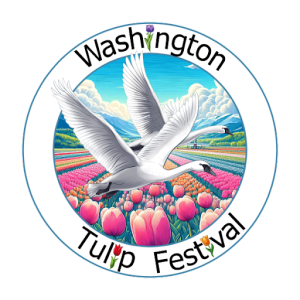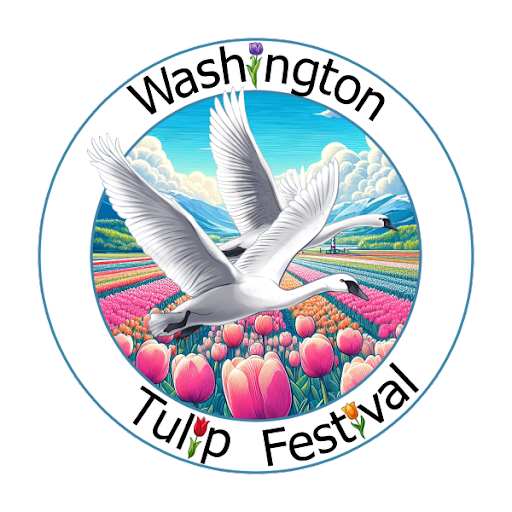Skagit County, Washington, is a paradise for birdwatchers and lovers of natural flower beauty.
 Among its many attractions, the trumpeter swan stands as a symbol of resilience and conservation success. With its impressive size, graceful presence, and melodious calls, the trumpeter swan is a must-see for any wildlife enthusiast. But the wonders of Skagit Valley don't end with its birdlife. Every year, the valley comes alive with the breathtaking colors of the Washington Tulip Festival, a truly unique event of birds and blooms that combines art and nature in a way that can only be experienced in Skagit County.
Among its many attractions, the trumpeter swan stands as a symbol of resilience and conservation success. With its impressive size, graceful presence, and melodious calls, the trumpeter swan is a must-see for any wildlife enthusiast. But the wonders of Skagit Valley don't end with its birdlife. Every year, the valley comes alive with the breathtaking colors of the Washington Tulip Festival, a truly unique event of birds and blooms that combines art and nature in a way that can only be experienced in Skagit County.
The Trumpeter Swan: A Bird of Grandeur
The trumpeter swan, North America's largest waterfowl and the heaviest flying bird on the continent is a sight to behold in Skagit County. With a wingspan that can reach up to an astonishing 8 feet, these majestic birds are not only a marvel to behold but also a testament to the power of human efforts to save a species from the brink of extinction. Their vocalizations, resembling the sound of a trumpet, add to the enchantment of witnessing them in their natural habitat.
A Triumph Over Extinction
The trumpeter swan's journey from near-extinction to recovery is a remarkable tale of conservation efforts and dedication. By 1933, the wild population of trumpeter swans had dwindled to as few as 69 individuals, pushing them to the brink of extinction. At that point, it seemed inevitable that these magnificent birds would vanish forever.
However, hope emerged from an unexpected source: aerial surveys discovered a thriving population of several thousand trumpeter swans around Alaska's Copper River. This discovery was a turning point, as it gave wildlife agencies and conservationists a glimmer of hope. Careful reintroductions, spearheaded by organizations like the Trumpeter Swan Society, gradually restored the North American wild population of trumpeter swans to over 46,000 birds by 2010. This incredible success story is a testament to the dedication and collaborative efforts of conservationists and bird lovers alike.
Skagit Valley: A Trumpeter Swan Sanctuary
Skagit Valley, located in the heart of Washington State, has become a sanctuary for trumpeter swans and a prime destination for birdwatchers. The valley's pristine wetlands, with minimal human disturbance, provide an ideal habitat for these graceful birds, especially during the breeding season. Here, in the tranquility of the valley, birdwatchers can witness the trumpeter swans in their natural element, displaying their courtship rituals and nurturing their young.
human disturbance, provide an ideal habitat for these graceful birds, especially during the breeding season. Here, in the tranquility of the valley, birdwatchers can witness the trumpeter swans in their natural element, displaying their courtship rituals and nurturing their young.
The Skagit River estuary, in particular, serves as a critical wintering ground for trumpeter swans. The valley's mild climate and abundant food sources make it an attractive destination for these majestic birds during the colder months. Birdwatchers who visit Skagit County during the winter are treated to the awe-inspiring sight of hundreds of trumpeter swans gliding gracefully across the waters, their calls echoing through the air.
Life of Trumpeter Swans in Skagit Valley
Trumpeter swans are known to form lifelong pair bonds, a testament to their loyalty and commitment to their mates. They often mate for life and can be seen gliding together in perfect harmony through the wetlands of Skagit County. The devotion these swans show to each other is a heartwarming sight for bird enthusiasts.
One of the unique characteristics of trumpeter swans is their distinct vocalizations. Their calls, resembling the sound of a trumpet, are both loud and somewhat musical. This melodious communication is a defining feature of these magnificent birds and adds to the enchantment of witnessing them in their natural habitat.
Conservation and Restoration Efforts
The history of trumpeter swans in the United States is a testament to the impact of human activities on wildlife populations. These birds were once hunted for their meat and beautiful white feathers, leading to a drastic decline in their numbers. By the year 1900, trumpeter swans had been heavily hunted and were virtually extinct in much of the United States. The use of the poisonous synthetic insecticide, DDT, caused the swan’s egg shells to become soft and brittle leading to few successful hatchings. This dangerous chemical in the swan’s food source plus over-hunting almost wiped out all of the swans in the lower 48 U. S. states.
Fortunately, conservation efforts, such as the establishment of the Red Rock Lakes National Wildlife Refuge, helped protect the remaining trumpeter swans in Yellowstone and the Centennial Valley of Montana. Additionally, the discovery of a small flock in Grand Prairie, Alberta, and Lost Lake B.C. Canada, and the identification of more populations in Alaska provided hope for their recovery. As a result, trumpeter swans were removed from the U.S. endangered species list in 1968, prior to the Endangered Species Act of 1973. Nevertheless, various states continue to list the trumpeter swan as either state-threatened or state-endangered, emphasizing the importance of continued conservation efforts. In 1970 only 7 trumpeter swans were recorded in Skagit County, today we proudly host 23,000 trumpeter swans each winter.
Unique Sightings: Leucistic Trumpeter Swans
While the majority of trumpeter swans have gray plumage when they hatch, there are rare exceptions. Occasionally, a cygnet may be pure white at birth, with dark eyes, and it is not an albino. This unique white variant is known as a "leucistic" color phase and is a rare and beautiful sight for birdwatchers lucky enough to spot one.
The Washington Tulip Festival: A Symphony of Colors
 But the marvels of Skagit County don't stop at its wildlife. Every year, Skagit County hosts the Washington Tulip Festival, a breathtaking event that brings together art and nature in a way that is truly unique to the region. The festival transforms the valley's commercial fields into a vibrant tapestry of colors, as millions of tulips burst into bloom.
But the marvels of Skagit County don't stop at its wildlife. Every year, Skagit County hosts the Washington Tulip Festival, a breathtaking event that brings together art and nature in a way that is truly unique to the region. The festival transforms the valley's commercial fields into a vibrant tapestry of colors, as millions of tulips burst into bloom.
The Washington Tulip Festival, typically held in April, showcases the incredible beauty of tulips in full bloom. Visitors from around the world are drawn to the valley to witness this extraordinary display of color and artistry. As you stroll through the fields of tulips, you'll be surrounded by an array of hues, from the fiery reds and brilliant yellows to the soft pastels and deep purples. It's a visual symphony that captivates the senses and leaves a lasting impression.
Combining Nature and Art
What makes Skagit County truly unique is the opportunity to combine the wonder of the trumpeter swan with the stunning beauty of the Washington Tulip Festival. Imagine starting your day with the serene sight and melodious calls of trumpeter swans in the wetlands, and then, as you explore the valley, transitioning into a world of vibrant colors at the tulip festival. It's a sensory experience like no other, where you can appreciate the artistry of nature and human creativity in a single day.
Conclusion
Skagit County, Washington, offers a rare and remarkable combination of natural beauty and artistic expression. Here, the trumpeter swan's story of resilience and recovery unfolds against the backdrop of pristine wetlands and serene waters. Additionally, the Washington Tulip Festival paints the valley with a kaleidoscope of colors, creating an unforgettable spectacle that can only be witnessed in Skagit County.
